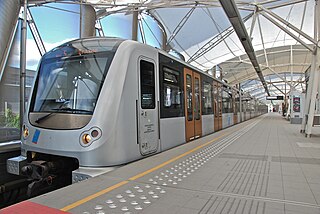
The Brussels Metro is a rapid transit system serving a large part of the Brussels-Capital Region of Belgium. It consists of four conventional metro lines and three premetro lines. The metro-grade lines are M1, M2, M5, and M6 with some shared sections, covering a total of 39.9 kilometres (24.8 mi), with 59 metro-only stations. The premetro network consists of three tram lines that partly travel over underground sections that were intended to be eventually converted into metro lines. Underground stations in the premetro network use the same design as metro stations. A few short underground tramway sections exist, so there is a total of 52.0 kilometres (32.3 mi) of underground metro and tram network. There are a total of 69 metro and premetro stations as of 2011.

De Brouckère is a rapid transit station located under the Place de Brouckère/De Brouckèreplein in central Brussels, Belgium. It consists of both a metro station and a premetro station. The station takes its name from that aboveground square, itself named after the former mayor of the City of Brussels, Charles de Brouckère.

Parc (French) or Park (Dutch) is a Brussels Metro station on lines 1 and 5. It is located under Brussels Park in central Brussels, Belgium. It has one entrance, at the intersection of the Rue Royale/Koningsstraat and the Rue de la Loi/Wetstraat, two of the main roads of the City of Brussels.

Brussels-Schuman railway station is a railway station in the City of Brussels, Belgium, serving the European Quarter. The station received its name from the aboveground Robert Schuman Roundabout, itself named after Robert Schuman, one of the founding fathers of the European Union, the Council of Europe and NATO.

Arts-Loi (French) or Kunst-Wet (Dutch) is a Brussels Metro station on lines 1, 2, 5 and 6. It is located in the City of Brussels, Belgium, under the intersection of the Rue de la Loi/Wetstraat and the Avenue des Arts/Kunstlaan, after which it is named, the latter street being part of the Small Ring.

Sainte-Catherine (French) or Sint-Katelijne (Dutch) is a Brussels Metro station on lines 1 and 5. It is located under the Place Sainte-Catherine/Sint-Katelijneplein, between the Quai aux Briques/Baksteenkaai and the Quai au Bois à Brûler/Brandhoutkaai, in the City of Brussels, Belgium. The station received its name from the aboveground Saint Catherine's Church, itself named after Saint Catherine.

Maelbeek or Maalbeek is a Brussels Metro station on lines 1 and 5. It is located under the Rue de la Loi/Wetstraat in the City of Brussels, Belgium. The station takes its name from the nearby Maalbeek stream.

Simonis and Elisabeth are two interconnected Brussels Metro stations serving lines 2 and 6 on two different levels, as well as a tram and bus stop. Additionally, Simonis railway station is a railway station operated by the National Railway Company of Belgium (SNCB/NMBS). It is served by the Brussels Regional Express Network (RER/GEN) service.

Porte de Hal or Hallepoort (Dutch) is a rapid transit station in Brussels, Belgium, consisting of both a metro station and a premetro station. The station is located in the municipality of Saint-Gilles, south of the City of Brussels, under the Small Ring and next to the 14th-century Halle Gate, after which it is named. It is one metro stop away or about ten minutes' walk from Brussels-South railway station.

Porte de Namur or Naamsepoort (Dutch) is a Brussels Metro station on the southern segment of lines 2 and 6. It is located under the Small Ring at the Square du Bastion/Bolwerksquare, next to the Chaussée d'Ixelles/Elsense Steenweg, in the municipality of Ixelles, south of the City of Brussels, Belgium. The station takes its name from the Namur Gate area, itself named after the Namur Gate in Brussels' old city walls.
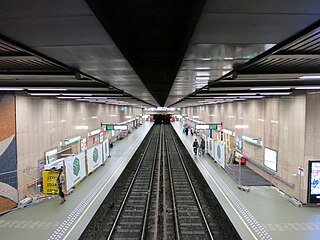
Trône (French) or Troon (Dutch) is a Brussels Metro station on the southern segment of lines 2 and 6. It is located under the Small Ring at the Place du Trône/Troonplein, near the Royal Palace, in the City of Brussels, Belgium.
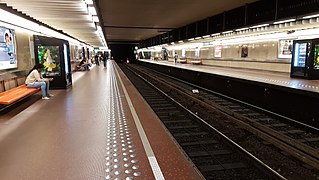
Madou is a Brussels Metro station on the northern segment of lines 2 and 6. It is located under the Small Ring at the Place Madou/Madouplein, next to Madou Plaza Tower, in the municipality of the Saint-Josse-ten-Noode, north of the City of Brussels, Belgium. The station takes its name from that aboveground square, itself named after the painter and lithographer Jean-Baptiste Madou.

Botanique (French) or Kruidtuin (Dutch) is a Brussels Metro station on the northern segment of lines 2 and 6. It is located under the Small Ring at the Rue Royale/Koningsstraat in the municipality of the Saint-Josse-ten-Noode, north of the City of Brussels, Belgium.

Rogier is a rapid transit station in Brussels, Belgium, consisting of both a metro station and a premetro station. It is located under the Small Ring at the Place Charles Rogier/Karel Rogierplein in the municipality of the Saint-Josse-ten-Noode, north of the City of Brussels. The station takes its name from that aboveground square, itself named after Charles Rogier, Belgium's 13th Prime Minister.

The premetro and tram route 3, is a tram route operated by STIB/MIVB, which connects connects the Esplanade stop with the Churchill stop in the southern municipality of Uccle. The line is named after the planned Metro line 3, which is set to service most of the current route of tram line 3. The line was temporarily disbanded, but returned in service on 30 June 2008. The colour of the signage for this line is lime-green.

The tram route 51 in Brussels, Belgium, is a tram route operated by STIB/MIVB, which connects Heysel/Heizel metro station in the City of Brussels to the Van Haelen stop in the municipality of Uccle. The route runs north–south, crossing the City of Brussels, Jette, Molenbeek-Saint-Jean, the City of Brussels again, Saint-Gilles, Forest and Uccle. Currently, service is interrupted between Brussels-South railway station and Altitude Cent/Hoogte Honderd due to construction work at Albert premetro station.
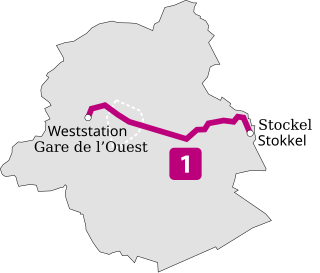
Line 1 is a rapid transit line on the Brussels Metro in Belgium operated by STIB/MIVB. It has existed in its current form since 4 April 2009, when former line 1B, which ran between Stockel/Stokkel and Erasme/Erasmus, was shortened to Gare de l'Ouest/Weststation. The section between Gare de l'Ouest and Erasme is now served by line 5. The line serves 21 metro stations, and has a common section with line 5 between Gare de l'Ouest and Merode, and with lines 2 and 6 between Gare de l'Ouest and Beekkant. At Arts-Loi/Kunst-Wet, the line also connects with lines 2 and 6. Railway connections are possible at Brussels-Central, Brussels-Schuman, Merode and Brussels-West. The line crosses the municipalities of Molenbeek-Saint-Jean, Koekelberg, City of Brussels, Etterbeek, Woluwe-Saint-Pierre and Woluwe-Saint-Lambert.

Line 5 is a rapid transit line on the Brussels Metro in Belgium operated by STIB/MIVB. It connects Herrmann-Debroux in the south-east of Brussels to Erasme/Erasmus in the south-west via the city centre. It has existed in its current form since 4 April 2009, when the section of former line 1A between Beekkant and Roi Baudouin/Koning Boudewijn was replaced by the section of former line 1B between Beekkant and Erasme. Starting from Herrmann-Debroux, the line crosses the municipalities of Auderghem, Etterbeek, City of Brussels, Molenbeek-Saint-Jean, Koekelberg and Anderlecht. It serves 28 metro stations and has a common section with line 1 between Gare de l'Ouest/Weststation and Merode, and with lines 2 and 6 between Gare de l'Ouest and Beekkant. At Arts-Loi/Kunst-Wet, the line also connects with lines 2 and 6. Railway connections are possible at Brussels-Central, Brussels-Schuman, Merode and Brussels-West.
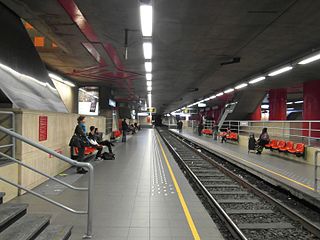
Gare du Midi (French) or Zuidstation (Dutch) is a rapid transit station in Brussels, Belgium, consisting of both a metro station and a premetro station.

Gare Centrale (French) or Centraal Station (Dutch) is a Brussels Metro station on lines 1 and 5. It is located five minutes' walk from Brussels-Central railway station, under the Marché au Bois/Houtmarkt, in the City of Brussels, Belgium, and can be accessed through a pedestrian tunnel.























